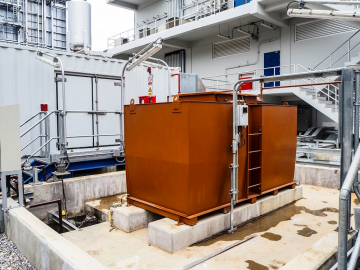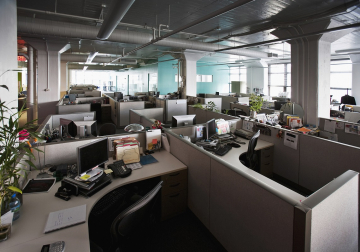For environment, health and safety (EHS) managers at technology companies, identifying, assessing and prioritizing potential risks in a lower-risk environment - from offices to call centers - is part of the job. And when it comes to EHS programs, compliance is just the start.
The following EHS checklist can serve as an assessment guide for EHS managers of low-risk technology facilities, including the basic requirements facilities need to meet. In addition, this checklist can help uncover other EHS opportunities. EHS programs not only ensure compliance with state and federal requirements, but can also cut costs, decrease a company’s environmental footprint, and boost company image.
As you read through the checklist, ask yourself: How do my company’s EHS programs stack up? Can I check everything off the list?
Get started and see where the risks and opportunities may exist.
Life Safety and Emergency Egress
- Emergency evacuation routes are clearly marked and are free from obstructions.
- Evacuation maps with fire pull, extinguisher, and first aid kit locations are posted in multiple areas, with two exit routes clearly marked.
- Emergency exit doors are clearly marked, are functioning properly, and open in the direction of travel.
- Emergency exits lead to a level and safe area that is clear of obstructions or impediments.
- Evacuation drills are conducted at least annually, with post-drill meetings held to discuss performance.
- Regular inspections are performed to ensure that evacuation routes and emergency exit areas are clear and free from obstructions.
Medical Emergencies
- Emergency response teams are formed and trained.
- Emergency contact information is posted and phone trees are available to managers.
- First aid supplies are well stocked and are audited and replenished regularly by an assigned employee.
- AEDs are checked regularly and maintained according to manufacturer’s recommendations.
- Eyewash stations and emergency showers are clean, functional and tested at a frequency that meets regulations.
Fire Safety
- Fire extinguishers are annually maintained by a third party.
- Fire extinguishers are visually inspected each month with tags dated and signed.
- Only trained personnel are approved to use fire extinguishers.
- Sprinkler systems are functioning properly and tested per NFPA 13 and NFPA 25 requirements.
- Fire alarms and strobes are functioning properly and tested annually.
- Combustible materials are not stored under stairwells or closer than 18" to fire sprinkler heads.
Slip/Trip/Fall Hazards
- Work areas are free of tripping hazards such as electrical cords, wires, free-standing electrical fixtures, or throw rugs or mats, or damaged carpet or tiles.
- Work area aisle ways and storage areas are orderly.
- Warning signs and/or mats are provided when floors are wet.
- Snow and ice removal is performed when needed.
- Exterior asphalt and paved areas are maintained to provide level walking surfaces.
Resource: Check out this infographic with 3 easy tips for making your technology workplace safer.
Offices and Workstations
- Furniture such as office chairs, desks and cabinets are in good condition and provide an ergonomically safe workstation.
- Tall cabinets or shelves are braced to prevent them from falling over.
- Cubicle walls are secured from falling and not damaged.
- Portable space heaters and personal appliances are not used unless approved.
Housekeeping
- Drinking fountains are maintained, clean and tested regularly.
- Staff refrigerators and freezers are cleaned out weekly and disinfected regularly.
- There are no combustible materials being stored in boiler, mechanical, or electrical rooms.
Maintenance
- Elevators are inspected regularly and certificates are up-to-date.
- Doors and locks are in good working order.
- Ceiling fixtures such as lighting, projectors, televisions and fire sprinkler heads are adequately secured.
- Temperature and humidity are kept at acceptable levels, and there are no signs of mold growth or water leakage in the facility.
- Burned-out lights are replaced promptly and handled as universal waste.
Material Handling & Storage
- Heavy objects and boxes are not stored at heights.
- Shelves and cabinets are in good working condition.
- Portable ladders are weight-rated, inspected before each use, and equipped with non-slip feet.
- Metal ladders are not used for electrical work.
Electrical Safety
- Electrical cords are not run under carpets, mats, doors or walls.
- Electrical panels are labelled, closed and undamaged.
- The spaces in front, to the sides of, and above electrical panels are kept clear and free for access.
- Extension cords are not used in place of permanent wiring.
- Power strips (relocatable power taps) are grounded and not daisy-chained together.
Waste and Recycling
- All wastes have been identified and classified, and are being disposed of or recycled per regulatory requirements.
- Waste containers are labeled, have an accumulation start date, and are kept closed when not in use.
- Waste areas have appropriate signage and security and are inspected per regulatory requirements.
- Common office wastes that are considered hazardous, which include spent fluorescent lamps, used batteries, electronic waste (e.g. old laptops, mice, or cell phones), and facility maintenance wastes including oils, auto batteries, paints and solvents, are dealt with appropriately.
Regulatory Permits
- The facility has identified and is complying with all regulatory requirements, including obtaining required permits, for owned and/or operated equipment and abatement devices.
- Common building equipment that may fall under regulatory requirements and require permits includes emergency generators, UPS generators, boilers, fire pump engines, and cooling towers.
- Ensure copies of all letters of interpretation, permits, licenses, and approvals have been obtained and conditions are being met.
Chemical Management
- Any new chemicals are reviewed for health and safety concerns prior to being brought onsite.
- Safety Data Sheets are maintained and available to all employees for all chemicals at the facility, including chemical samples.
- Safety Data Sheets for materials no longer used are dated and archived.
- All flammable chemicals over 10 gallons aggregate quantity, are kept in self closing and locking flammable storage cabinets.
- ASTs and USTs containing chemicals or petroleum are inspected at least weekly for integrity and tested per ASTM schedule and requirements.
Program Administration
- All incidents and near misses are being reported (internally and externally) in a timely manner.
- All incidents are investigated as to root cause, and corrective and preventative actions are agreed upon by all parties involved and assigned to be completed in a timely manner.
- Corrective and preventive actions are tracked to closure.
- Employee safety training is completed on time, with training content and attending personnel recorded.
- OSHA and labor posters explaining employee rights are displayed, complete, and updated annually.
Resource: See all the employer responsibilities for a safe work environment as outlined by OSHA.
If you’re unable to check off all of the above EHS considerations, start by prioritizing the most pressing issues to tackle first, as well as any low-hanging fruit items that can be quickly or easily remedied.
If you are unsure, or need help, consider reaching out to an EHS consultant to ensure your facility is meeting all regulatory compliance requirements.
For information on how EHS consulting services can help you maintain a healthier and more productive workplace, reduce business disruptions and liability, preserve your brand’s image and meet stakeholder expectations, check out our RiskRight EHS® services.
Want more news and insights like this?
Sign up for our monthly e-newsletter, The New Leaf. Our goal is to keep you updated, educated and even a bit entertained as it relates to all things EHS and sustainability.
Get e-NewsletterHave any questions?
Contact us to discuss your environment, health, safety and sustainability needs today.






